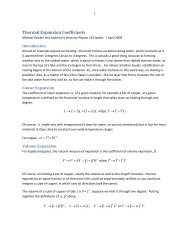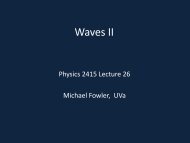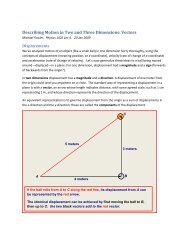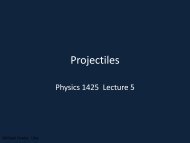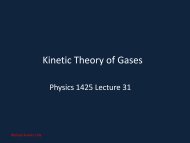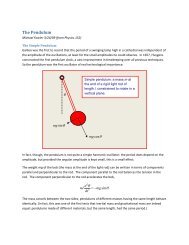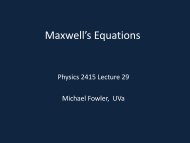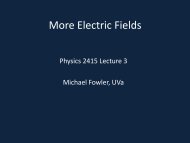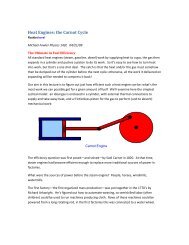Class Notes on Rotational Motion - Galileo and Einstein
Class Notes on Rotational Motion - Galileo and Einstein
Class Notes on Rotational Motion - Galileo and Einstein
You also want an ePaper? Increase the reach of your titles
YUMPU automatically turns print PDFs into web optimized ePapers that Google loves.
9Now comes a crucial point. How do we relate this torque to the external force torque FR? What aboutall the internal forces—the fact that each part of the wheel feels forces from neighboring parts? How dowe take account of this very complicated situati<strong>on</strong>?The answer is: we d<strong>on</strong>’t have to! By Newt<strong>on</strong>’s Third Law, all those internal forces are in equal oppositepairs, acti<strong>on</strong>s <strong>and</strong> reacti<strong>on</strong>s between neighboring masses. This means that when we sum over all partsof the wheel, we count all these forces, <strong>and</strong> they all cancel each other in pairs.Therefore the total torque is just that from the external forces.It follows that the analog of Newt<strong>on</strong>’s Sec<strong>on</strong>d Law for rotati<strong>on</strong> about an axle isTorque = Iwhere the moment of inertia I is given by m i r i 2 = dmr 2 . (And remember that as always theaccelerati<strong>on</strong> must be measures in radians/sec 2 .)Moments of Inertia: Hoops, Disks, Cylinders, Rods.Finding the moment of inertia l is now just a matter of doing elementary integrals. For the case of ahoop of mass M, where all the mass can be taken at the same distance R from the axis of rotati<strong>on</strong>, nointegral at all is necessary:For a hoop, I = MR 2 .A disk can be thought of as c<strong>on</strong>structed of successive hoops, like a two-dimensi<strong>on</strong>al <strong>on</strong>i<strong>on</strong>. As apractical matter, the best approach is to use the two-dimensi<strong>on</strong>al density, call it , (units: kg/m 2 ) sothat the total mass of the disk is density x total area, M = R 2 . Then the “hoop” which is that part ofthe disk between r <strong>and</strong> r + Δr from the center has mass m = 2rΔr , <strong>and</strong> that hoop has moment ofinertia mr 2 = (2rΔrr 2 . A disk can be seen asmade of c<strong>on</strong>centrichoops glued together.Raxlerr + Δr




